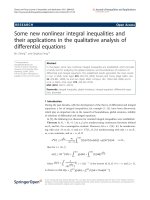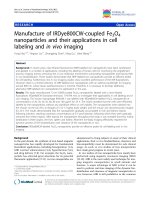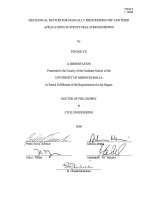Low dimensional band limited framelets and their applications in colour image restoration
Bạn đang xem bản rút gọn của tài liệu. Xem và tải ngay bản đầy đủ của tài liệu tại đây (18.84 MB, 147 trang )
LOW DIMENSIONAL BAND-LIMITED
FRAMELETS AND THEIR APPLICATIONS
IN COLOUR IMAGE RESTORATION
HOU LIKUN
(B.Sc., USTC, China)
A THESIS SUBMITTED
FOR THE DEGREE OF DOCTOR OF PHILOSOPHY
DEPARTMENT OF MATHEMATICS
NATIONAL UNIVERSITY OF SINGAPORE
2013
To my parents
DECLARATION
I hereby declare that the thesis is my original
work and it has been written by me in its entirety.
I have duly acknowledged all the sources of infor-
mation which have been used in the thesis.
This thesis has also not been submitted for any
degree in any university previously.
Hou Likun
April 2013
Acknowledgements
Firstly, I would like to express the sincerest thanks to my supervisor, Professor
Shen Zuowei. Professor Shen is not only an outstanding figure in mathematical
science, but also a person full of kindness and being supportive. In his research, he
always sees through the fundamental things and has deep insight into the connec-
tions between different research fields. This way of thinking and doing mathematics
has greatly influenced my research. Moreover, Professor Shen also encourages me
to do research on my own, and helps me to cultivate self-confidence and indepen-
dent thinking during our regular discussions. I feel a bit sorry for not meeting his
expectations though. All in all, it could not be a greater honour to have him being
my supervisor all through this PhD journey.
Secondly, I want to express great gratitude towards Professor Ji Hui for con-
ducting our weekly seminars on image processing. Through those seminars I have
gained a lot in both theoretical and applicational aspects. His profound knowl-
edge, broad vision and critical thinking have greatly helped me in my research.
Besides, it is a lifelong benefit to have the opportunity to do some research under
his guidance as well. From him I got some valuable experiences, and under his
v
vi Acknowledgements
guidance I also learned the correct altitude towards doing research.
Thirdly, I want to thank the Department of Mathematics and National Uni-
versity Singapore for providing me good environment and scholarships for my
research and study. I would also like to thank the Faculty of Science for funding
me to attend the 8
th
MPSGC in Thailand.
Lastly, I want to thank deeply to my friends and colleagues here for their
encouragement and support. Many thanks to Dr. Pan Suqi, Dr. Jiang Kaifeng,
Dr. Miao Weimin, Wang Kang, Li Jia, Gong Zheng, Zhou Junqi, Sun Xiang, Wang
Yi, Ji Feng and Wu Bin. Without the company of you guys, this journey would
be lonely and life would lose its colours.
Contents
Acknowledgements v
Summary xi
1 Introduction 5
1.1 Band-limited wavelets and wavelet frames . . . . . . . . . . . . . . 8
1.2 Digital colour image restoration . . . . . . . . . . . . . . . . . . . . 10
1.3 Organization of this thesis . . . . . . . . . . . . . . . . . . . . . . . 13
2 Preliminaries 15
2.1 Multiresolution analysis, Riesz wavelets and wavelet frames . . . . . 16
2.1.1 Multiresolution analysis . . . . . . . . . . . . . . . . . . . . 16
2.1.2 Riesz wavelets and wavelet frames . . . . . . . . . . . . . . . 20
2.1.3 Extension principles for derving MRA-based wavelet tight
frames . . . . . . . . . . . . . . . . . . . . . . . . . . . . . . 23
vii
viii Contents
2.1.4 For the construction of Riesz wavelets and orthonormal wavelets
in low dimensions . . . . . . . . . . . . . . . . . . . . . . . . 31
2.2 Band-limited functions . . . . . . . . . . . . . . . . . . . . . . . . . 32
2.3 Colour spaces . . . . . . . . . . . . . . . . . . . . . . . . . . . . . . 35
2.3.1 The CIEXYZ colour space . . . . . . . . . . . . . . . . . . . 36
2.3.2 The CIExyY colour space and the CIExy chromaticity diagram 37
2.3.3 RGB colour space . . . . . . . . . . . . . . . . . . . . . . . . 38
2.3.4 HSV colour space . . . . . . . . . . . . . . . . . . . . . . . . 40
2.3.5 LAB colour space . . . . . . . . . . . . . . . . . . . . . . . . 41
2.4 Wavelet tight frame based image restoration models . . . . . . . . . 43
2.4.1 The general framelet based image restoration model . . . . . 46
2.4.2 Synthesis based model, analysis based model and balanced
model . . . . . . . . . . . . . . . . . . . . . . . . . . . . . . 46
2.4.3 Numerical solvers of image restoration models . . . . . . . . 48
3 Band-limited Tight Frames in Low Dimensions 55
3.1 On the construction of non-separable band-limited refinable functions 55
3.2 Auxiliary lemmas, theorems and corollaries . . . . . . . . . . . . . . 57
3.3 Constructions of band-limited wavelet tight frames . . . . . . . . . 63
3.4 Examples . . . . . . . . . . . . . . . . . . . . . . . . . . . . . . . . 67
4 Non-separable Band-limited Stable Refinable Functions, Riesz
Wavelets and Orthonormal Wavelets in Low Dimensions 71
4.1 Two results on band-limited refinable functions . . . . . . . . . . . 72
4.2 The construction of band-limited stable refinable functions and wavelets 75
Contents ix
4.2.1 The construction of non-separable band-limited stable refin-
able functions . . . . . . . . . . . . . . . . . . . . . . . . . . 75
4.2.2 Construction of band-limited Riesz wavelets and orthonor-
mal wavelets . . . . . . . . . . . . . . . . . . . . . . . . . . . 85
4.3 Examples . . . . . . . . . . . . . . . . . . . . . . . . . . . . . . . . 87
5 Recovering Over/Under-exposed Regions of Digital Colour Pho-
tographs 91
5.1 Problem formulation and the workflow . . . . . . . . . . . . . . . . 92
5.1.1 Problem formulation . . . . . . . . . . . . . . . . . . . . . . 92
5.1.2 Basic idea and the workflow . . . . . . . . . . . . . . . . . . 95
5.2 Review of Related works . . . . . . . . . . . . . . . . . . . . . . . . 96
5.3 The main algorithm . . . . . . . . . . . . . . . . . . . . . . . . . . . 99
5.3.1 Inpainting in lightness channels L . . . . . . . . . . . . . . . 100
5.3.2 Lightness adjustment . . . . . . . . . . . . . . . . . . . . . . 103
5.3.3 Recovering the chromatic channels [a; b] . . . . . . . . . . . 110
5.4 Numerical experiments and discussions . . . . . . . . . . . . . . . . 117
5.4.1 Experimental evaluation . . . . . . . . . . . . . . . . . . . . 118
5.4.2 Conclusions and future work . . . . . . . . . . . . . . . . . . 120
Bibliography 124
Summary
This thesis consists of two major parts. The first part focuses on the theoreti-
cal study on the construction of band-limited framelets with good time-frequency
localization property in low-dimensional Euclidean spaces. Based on the univari-
ate Meyer’s refinable function, this thesis provides a systematic approach to con-
struct non-separable band-limited refinable functions, Riesz wavelets, orthonormal
wavelets as well as wavelet tight frames (framelets) in 2D and 3D Euclidean spaces.
With the newly constructed band-limited framelets in hand, the second part of
the thesis focuses on the application of non-separable band-limited framelets and
tensor-product spline framelets in colour image restoration. The main applica-
tion explored in this thesis is on repairing over-exposed and under-exposed regions
in regular digital colour photographs. By using wavelet tight frame based regu-
larization methods and some tone mapping analogy, we develop in this thesis a
comprehensive computational method to simultaneously (i) recover brightness val-
ues clipped due to over/under-exposure, (ii) enhance the contrast of under-exposed
regions so that more visible image details could be revealed, and (iii) restore the
chromatic values damaged due to over-exposure. Experimental results show that
xi
xii Summary
the proposed method outperforms existing approaches in the test data set.
Basic Concepts and Notations
• In this thesis, we use Z, Z
∗
, Z
+
, R to denote the set of integers, nonnegative
integers, positive integers, and real numbers respectively.
• For any positive integer N, we use Z
N
to denote the quotient set Z/NZ (or
equivalently the set {0, 1, ··· , N − 1}).
• Cartesian product. Given n sets A
j
, j = 1, 2, . . . , n, we denote
A
1
× A
2
× ···×A
n
= {(x
1
, x
2
, . . . , x
n
) : x
1
∈ A
1
, . . . , x
n
∈ A
n
}.
In particular, if A
1
= A
2
= ··· = A
n
= A, then we denote A
1
×A
2
×···×A
n
as A
n
for simplicity.
• For any d ∈ Z
+
, we let R
d
denote the d-dimensional Euclidean space with
the inner product given by
x · y =
d
j=1
x
j
y
j
, for x = (x
1
, . . . , x
d
) and y = (y
1
, . . . , y
d
) ∈ R
d
.
1
2 Summary
• For a countable index set I, we let
p
(I), 1 p ∞, be the set of all
complex-valued sequences on I such that
c
p
:=
k∈I
|c(k)|
p
1/p
< ∞, 1 p < ∞;
sup
k∈I
|c(k)| < ∞, p = ∞.
• For any n ∈ Z
∗
, we let C
n
(R
d
) denote the set of functions on R
d
that have
continuous derivatives up to order n, and C
∞
(R
d
) denote the set
n∈Z
∗
C
n
(R
d
).
• L
p
(R
d
) (1 p ∞) spaces. L
p
(R
d
) is the set of Lebesgue measurable
functions on R
d
such that
f
L
p
(R
d
)
:=
R
d
|f(x)|
p
dx
1
p
< ∞, 1 p < ∞;
ess sup{|f(x)|, x ∈ R
d
} < ∞, p = ∞.
In particular, when p = 2, the space L
2
(R
d
) is a Hilbert space with its norm
induced by the inner product ·, · defined as follows
f, g =
R
d
f(x)g(x) dx, ∀f, g ∈ L
2
(R
d
),
where g(x) is the complex conjugate of g(x).
• Fourier transform. For any function f ∈ L
1
(R
d
), its Fourier transform
f is
defined as
f(ξ) :=
R
d
f(x) exp(−iξ ·x)dx, ξ ∈ R
d
.
The definition of Fourier transform can be naturally extended to L
2
(R
d
) as
well as tempered distributions. Particularly, for any f ∈ L
2
(R
d
), one has the
following Parseval’s identity:
f
2
L
2
(R
d
)
=
1
(2π)
d
f|
2
L
2
(R
d
)
.
So f ∈ L
2
(R
d
) if and only if
f ∈ L
2
(R
d
). Moreover, Fourier transform is
invertible in L
2
(R
d
), and the inversion formula is formally given by
f(x) =
1
(2π)
d
R
d
f(ξ) exp(ix · ξ)dξ, x ∈ R
d
.
Summary 3
• Discrete Fourier transform. Given a d-dimensional signal u defined on the
grid N := Z
N
1
× Z
N
2
× ··· × Z
N
d
, the discrete Fourier transform of u is a
discrete signal F(u) defined on the grid K := (2πZ
N
1
/N
1
) × (2πZ
N
2
/N
2
) ×
···×(2πZ
N
d
/N
d
) such that
F(u)[k] =
1
|N|
n∈N
u[n] exp(ik · n),
where |N| = N
1
N
2
···N
d
. Discrete Fourier transform is also invertible: for
any v define on the grid K, its inverse discrete Fourier transform is
F
−1
(v)[n] =
1
|N|
k∈K
v[k] exp(−in ·k), ∀n ∈ N.
• Circular convolution. Given two finite signals u, v ∈ R
N
1
×R
N
2
×···×R
N
d
,
N
n
∈ Z
+
, n = 1, . . . , d, their circular convolution u v is a finite signal
of dimension N
1
× N
2
× ··· × N
d
such that, for any [k
1
, k
2
, . . . , k
d
] with
0 k
i
< N
i
, i = 1, 2, . . . , d,
u v[k
1
, k
2
, . . . , k
d
]
=
N
1
−1
n
1
=0
. . .
N
d
−1
n
d
=0
u
p
[k
1
− n
1
, k
2
− n
2
, . . . , k
d
− n
d
]v
p
[n
1
, n
2
, . . . , n
d
],
where u
p
and v
p
are the N
1
× N
2
× ··· × N
d
-periodic extension of u and v
respectively, i.e.
u
p
[n
1
, . . . , n
d
] = u[n
1
mod N
1
, . . . , n
d
mod N
d
]
and
v
p
[n
1
, . . . , n
d
] = v[n
1
mod N
1
, . . . , n
d
mod N
d
]
for any [n
1
, . . . , n
d
] ∈ Z
d
.
4 Summary
• Fourier series and Fourier coefficients. For any c ∈
2
(Z
d
), its Fourier series
c is a 2π-periodic function defined by
c(ξ) =
k∈Z
d
c[k] exp (−ik ·ξ).
Conversely, for any 2π-periodic function g, Fourier coefficients of g are formed
by a sequence c := {c[k], k ∈ Z
d
} such that
c[k] =
1
(2π)
d
[−π,π)
d
g(ξ) exp (ik · ξ)dξ, k ∈ Z
d
.
• Bracket product. For any f ∈ L
2
(R
d
) and any g ∈ L
2
(R
d
), their bracket
product [f, g] defined as
[f, g](ξ) =
k∈Z
d
f(ξ + 2πk)g(ξ + 2πk), ∀ξ ∈ R
d
.
In particular,
[f, f] =
k∈Z
d
|f(ξ + 2πk)|
2
.
It is easy to see by definition that [f, g] is 2π-periodic and [f, g] ∈ L
1
(T
d
),
where T
d
:= R
d
/(2πZ
d
).
Chapter 1
Introduction
Wavelets, which have been a fast growing research topic in the last few decades, are
a versatile tool that possesses both rich mathematical content and great potential
for applications. The versatility of wavelets is reflected in its various understand-
ing from different groups of researchers. For instance, some people view wavelets
as bases for certain function spaces, and some people view wavelets as a tool for
spatial-frequency analysis. In general, wavelets are a special type of oscillatory
functions with good spatial-frequency localization property. The oscillation na-
ture of wavelets make them effective in capturing discontinuities or sharp spikes in
data and functions, which induces a very powerful mathematical tool called wavelet
transform. By applying (dyadic) dilations and translations, a set of wavelet pro-
totype functions (usually referred as the set of mother wavelets) will generate a
basis. This basis can provide a powerful tool for cutting up data and functions
into different frequency bands and then analyzing each band with the desired scale
or resolution.
5
6 Chapter 1. Introduction
Given a set of mother wavelets Ψ ⊂ L
2
(R
d
), we can apply dilations and trans-
lations to it and consequently obtain a basis as follows
X(Ψ) := {ψ
j,k
:= 2
jd/2
ψ(2
j
· −k), ψ ∈ Ψ, j ∈ Z, k ∈ Z
d
},
where the dilation factor 2
j
controls the scale of wavelets and the translation
factor k indicates the position. Then for any generic signal (or function) f with
finite energy (i.e.
|f(t)|
2
dt < ∞), we can analyze f over its wavelet coefficients
computed as follows
c
ψ,j,k
= f, ψ
j,k
, ψ ∈ Ψ, j ∈ Z, k ∈ Z
d
.
In particular, when certain constraints (like high order vanishing moments) are
imposed for those mother wavelets, the derived basis would define sparse repre-
sentations of piecewise regular signals – namely, most wavelet coefficients are close
to zero except those located at the neighbourhood of singular points. The sparse
representation of given data and signal could be of help to certain post-processing
techniques, like compression, denoising, etc.
Early development of wavelets is largely devoted to orthonormal cases. In 1909,
A. Haar proposed the first example of orthonormal wavelet, which is currently
known by the name of Haar wavelet. Theoretical study of wavelet and its rigor-
ous formulation dated back to late 1970s and early 1980s. A major breakthrough
for wavelet theory is the introduction of multiresolution analysis (MRA) by Mal-
lat and Meyer [51, 56], whose emergence has greatly facilitated the construction
of wavelets. Specially, a class of MRA-based compactly supported orthonormal
wavelets was successfully constructed by Daubechies [26, 27], which is now widely
recognized as the family of Daubechies wavelets. Daubechies wavelets are quite
popular currently, and they have been adopted in many scientific research fields.
Along with the study of orthonormal wavelet basis, there had been a continuing
research effort in the study of wavelet frames. In history, frames were introduced
7
by Duffin and Schaeffer in 1952 to study non-harmonic Fourier series [38]. The
major difference between frames and orthonormal bases is that frames can be over-
complete (or to say redundant). Univariate wavelet frames were early explored by
Daubechies, Grossmann and Meyer in [29] in 1986. Similar as the case of orthon-
romal wavelet basis, the formulation of MRA [51, 56] is a major breakthrough for
constructing wavelet frames as well. However, the original formulation of MRA
is mainly designed for understanding and constructing orthonormal wavelet frame
bases rather than redundant wavelet frame bases. In order to construct redun-
dant wavelet frame bases, the originally MRA formulation was inevitably adapted
and generalized. For example, J. Benedetto and S. Li proposed the notion of
frame multiresolution analysis (FMRA) in [1], consequently several type of uni-
variate FMRA based wavelet frames were constructed. Following a similar route,
the construction of FMRA-based multivariate tensor-product wavelet frames was
pushed forward in [2] in 2007. In contrast to Mallat and Meyer’s original MRA
and FMRA, a more general concept of MRA was formulated in [5], which has been
a major motivation to the construction of wavelets and wavelet frames since its
formulation. Yet, the MRA structure itself does not suggest the characterization
of wavelet frames. A general characterization of multivariate wavelet frames was
obtained by Ron and Shen in [62] in 1997. This characterization was also explic-
itly obtained by B. Han in [46]. However, this wavelet frame characterization is
usually quite difficult to verify, which severely limits its practical use. Ron and
Shen were able to combine the frame characterization with the MRA formulation
raised in [6], and consequently proposed the renowned unitary extension principle
and oblique extension principle for constructing wavelet tight frames [62]. Com-
pared to other wavelet frame characterizations, the conditions indicated in the two
extension principles are practically easy to check, which makes the construction of
wavelet tight frames painless [62, 28].
8 Chapter 1. Introduction
This thesis is devoted to both the theory and the application of wavelets and
wavelet frames, in which two major topics would be covered:
• low-dimensional band-limited wavelets and wavelet tight frames (framelets),
• wavelet tight frame based digital colour image restoration.
In this opening chapter, we first give a brief introduction on the above two topics
to be studied in this thesis. After that, we will present the organization of this
thesis.
1.1 Band-limited wavelets and wavelet frames
In the development of wavelet theory, the study of compactly supported wavelets
and wavelets frames is the main stream. For instance, the renowned Harr wavelet,
Daubechies wavelets [27] and spline wavelet frames [62] and pseudo-spline wavelet
frames [28, 33] are all compactly supported. These wavelet constructions have
been adopted and utilized in many different scientific research fields. However,
there are certain cases in which the use of compactly supported wavelets would
be inappropriate. For example, in certain applications the targeted signals would
have their frequency components restricted to certain bands, the so-called band-
limited case. As a compactly supported function can never be band-limited unless
it is trivially zero, compactly supported wavelets and wavelet frames are unlikely
to provide an efficient tool to analyze and process such band-limited signals. So
in that case, the desired type of wavelets would be band-limited wavelets, i.e. the
type of wavelets whose support in frequency domain is compact.
To date, well-known examples of band-limited wavelets include the orthonormal
Shannon wavelets and the Meyer’s wavelets [55]. Besides these two renowned ex-
amples, a systematic study of band-limited wavelet frames using FMRA was given
1.1 Band-limited wavelets and wavelet frames 9
by Benedetto and Li in [1]. Recently, Chen and Goh gave a comprehensive study of
univariate band-limited wavelets and wavelet frames derived using extension prin-
ciples in [22]. However, most of these studies concentrate on the 1D case, while
2D and higher-dimensional cases are handled via the tensor product of 1D band-
limited wavelets (see e.g. [52, 2]). 2D tensor-product band-limited wavelets have
been used in various image processing tasks. For instance, the Meyer’s wavelets
are used in [35] for image deblurring and used in [66] for image compression. To
the best of our knowledge, the systematic construction of non-separable multi-
variate band-limited wavelets had not been well studied in the past. Compared
to tensor-product multivariate band-limited wavelets, non-separable band-limited
wavelets have more degrees of freedom, which is likely to result in better designs
such as smaller frequency support with fast rate of spatial decay.
In this thesis, we provide a systematic study on band-limited non-separable
wavelets and wavelet tight frames in low-dimensional Euclidean spaces including
R
2
and R
3
. Our major contributions include:
• the introduction of a new class of non-separable band-limited refinable func-
tions, and the construction of their associated band-limited non-separable
wavelet tight frames.
• the introduction of a new class of non-separable stable band-limited refin-
able functions, and the construction of their associated band-limited Riesz
wavelets as well as orthonormal wavelets.
Band-limited wavelets always vary smoothly in spatial domain. The oscillatory
and smoothness nature make them effective in capturing smoothness variations
in data sets and signals. Those smoothness variations are not rare to see in life.
For example, when light is reflected on a surface of the same material with similar
reflection property, the lightness intensities observed around the surface would
10 Chapter 1. Introduction
have smooth variations. However, such strong reflections are often associated with
image degradation like over-exposure, a phenomenon that can be frequently seen in
many digital colour photographs. In digital photography, over-exposure can often
produce regions with pixel lightness values clipped at the maximum supporting
limit, so those regions would be almost totally flat without any lightness variations.
In view of the above discussion, the constructed band-limited framelets in this
thesis is likely to be a good tool for restoring the lightness variations within those
clipped regions due to over-exposure. However, for restoring digital colour pho-
tographs, besides lightness degradation, the chromatic degradation needs to be
considered as well. This leads us to the problem of digital colour image restora-
tion.
1.2 Digital colour image restoration
Image restoration is a general topic, which includes sub-topics like image denoising,
deblurring, inpainting, super-resolution, etc. The main difficulty for image restora-
tion relies on the fact that those problems are commonly ill-posed. To resolve the
ill-posedness of those problems, some regularization methods are needed. In recent
years, wavelet frame based
1
-regularization methods have been demonstrated to
be very effective in image restoration (see, e.g. [17, 19, 16, 8, 15, 10, 13]).
Regular image restoration models are usually designed for 2D greyscale im-
ages. The complexity of colour perception and rendering in digital photography
makes colour image restoration problem practically difficult. As we know, digital
photography is about capturing photographs of scenes and objects using a cam-
era equipped with electronic sensors. The captured photographs are then digitized
and stored in computer file format for viewing or further post-processing. To shoot
digital photographs with reasonable fair quality, there are several camera settings
1.2 Digital colour image restoration 11
to consider, including white balance, shutter speed, ISO, aperture, focal length,
lens focus, etc. Among all those digital camera settings, the shutter speed, ISO
and aperture are known to determine the exposure of the resulting digital pho-
tograph. In digital photography, exposure controls how much light can reach the
digital sensors and the lightness of a photograph is determined by the amount of
light shown. Inappropriate exposure may cause the loss of scene details in the final
output. Besides that, there is a physical limitation on the dynamic range (ratio of
maximum lightness and minimum lightness) that a camera can endure. An out-
door scene with strong or harsh lighting often has a much larger dynamic range
than the bearing capacity of a regular image sensor, which then will lead to a loss
of highlight/shadow details in the resulting photograph. For example, the dynamic
range of a regular digital camera is about 10
3
: 1 while the dynamic range of an
outdoor scene on a sunny day ranges from 10
5
: 1 to 10
9
: 1. When recording such
a high dynamic range (HDR) scene using a low dynamic range (LDR) camera, the
out-coming digital photograph would often be degraded. Typically in that case,
some bright parts of the scene would be recorded as “white”, which is described
as over-exposure; in the mean time, some dark areas would be indistinguishable
from“black” in the image, which is described as under-exposure. In other words,
the lightness values of those over-exposed pixels are clipped at the maximum value
(e.g. 100) such that these pixels only show white colour, as the values of three
colour channels (red, green, blue) at these pixels are also the maximum value.
Similarly, the lightness values of under-exposed pixels are too small, close to the
minimum value (e.g. 0), such that the image details can hardly be visually per-
ceived. See Figure 1.1 for an illustration of photographs with over-exposed and
under-exposed regions.
In summary, for restoring digital colour photographs with over/under-exposed
regions, the following issues need to be handled:
12 Chapter 1. Introduction
(a) (b)
Figure 1.1: Two sample photographs with over/under-exposures. In the image shown
in (a), the foreground leaves appear over-exposed and background behind looks under-
exposed. In the image shown in (b) from [40], many regions of the church are over-
exposed and many parts of the wall with plants are under-exposed.
(i) the clipped lightness values due to over/under-exposure,
(ii) the nearly invisible image details in under-exposed regions,
(iii) the missing chromatic information in the over-exposed regions.
Among all 3 issues listed as above, the 1st and 2nd one are about the lightness
information of the photograph, while the 3rd one is about the chromatic infor-
mation of the photograph. Typically, the lightness values and chromatic values
have significantly different behaviour in digital photographs. For instance, in re-
gions around clipped pixels due to over/under-exposure, lightness values tend to
vary smoothly, which could possibly be fitted by smooth enough basis functions
like band-limited framelets. However, around the same regions, the chromatic
values possess more visible variations that are not smooth in appearance, which
reflects the corresponding image details. In view of these facts, the strategy for
recovering clipped lightness values and the one for restoring the missing chromatic
information should be carefully designed so as to reveal these differences.
In this thesis, we proposed a wavelet tight frame based method for restoring
1.3 Organization of this thesis 13
digital colour photographs with over/under-exposed regions. Our main contribu-
tions include:
(i) a band-limited framelet based regularization method for recovering clipped
lightness values in over/under-exposed regions;
(ii) a new lightness attenuation function for simultaneously accommodating the
recovered lightness and improving the contrast of under-exposed regions with-
out amplifying image noise;
(iii) a tensor-product spline framelet based inpainting method for recovering the
missing chromatic details of over-exposed regions.
1.3 Organization of this thesis
The rest of this thesis is organized as follows. Firstly in Chapter 2, we will give
some preliminaries including multiresolution analysis (MRA), wavelets and wavelet
frames, colour spaces and wavelet tight frame based image restoration models.
Then in Chapter 3, we will introduce the construction of non-separable band-
limited wavelet tight frames in low-dimensional Euclidean spaces including R
2
and
R
3
. Next in Chapter 4, we will focus on the construction of non-separable band-
limited Riesz wavelets and orthonormal wavelets in R
2
and R
3
. Finally in Chapter
5, we will turn to the application part, and present the details of our approach for
digital colour image restoration using wavelet tight frames. Numerical results and
discussions will be provided in this chapter as well.









